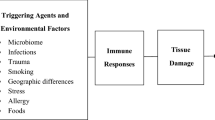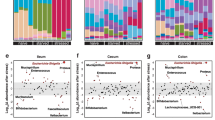Abstract
The incidence of endogenous infectious inflammatory diseases has dramatically increased in the population during the past 50 years. The causative agents of these diseases are representatives of the body’s commensal microflora, to which oral tolerance (OT) of the host develops. Disorders of this tolerance promote the development of various infections. The OT can fail as a result of stress factors acting on microorganisms, first of all, unreasonably wide use of antibacterial drugs. On the basis of the results of this study and literature data, it is shown that the abolishment of the body’s tolerance to its commensal microflora and the development of endogenous inflammations, which, in turn, induce allergic, autoimmune, and systemic diseases, are caused by a multiple increase in the level of heat shock proteins on the surface of microorganisms under the influence of stress. The pathogeneses of endogenous inflammatory diseases and therapeutic approaches are discussed.
Similar content being viewed by others
References
Lebedev, K.A. and Ponyakina, I.D., Immunophysiology of Epithelial Cells and Pattern Recognition Receptors, Fiziol. Chel., 2006, vol. 32, no. 2, p. 224 [Hum. Physiol. (Engl. Transl.), 2006, vol. 32, no. 2, p. 224].
Bourlioux, P., Koletzko, B., Guarner, F., and Braesco, V., The Intestine and Its Microflora Are Partners for the Protection of the Host, Am. J. Clin. Nutrition, 2003, vol. 78, no. 4. p. 675.
Ivanov, V.S., Zabolevaniya parodonta (Periodontium Diseases), Moscow: MIA, 2001.
Brandtzaer, P., Current Understanding of Gastrointestinal Immunoregulation and Its Relation to Food Allergy, Ann. N.Y. Acad. Sci., 2002, vol. 964. p. 13.
Garside, P. and McMowat, A.I. Oral Tolerance in Disease, GUT, 1999, vol. 44, p. 137.
Smith, K.M., Eaton, A.D., Finlayson, L.M., et al., Oral Tolerance, Am. J. Respir. Crit. Care Med., 2000, vol. 162, no. 4, p. 343.
Lebedev, K.A., Impairment of the Tolerance of an Organism to Its Own Microflora Is a Kind of Immune Pathology, Fiziol. Chel., 2003, vol. 29, no. 2, p. 138 [Hum. Physiol. (Engl. Transl.), 2003, vol. 29, no. 2, p. 258].
Cario, E. and Podolsky, D., Intestinal Epithelial Tolerance versus Intolerance of Commensals, Mol. Immunol., 2005, vol. 42, no. 8, p. 887.
Sakaguchi, S., Naturally Arising Foxp3-Expressing CD25+CD4+ Regulatory T cells in Immunological Tolerance to Self and Non-Self, Nature Immunol., 2005, vol. 6, p. 345.
Kyblack, J.G., Microbiology. Principles and Applications, Upper Saddle River: Prentice Hall, 1996, 3rd edition.
Lebedev, K.A. and Petrov, R.V., Immunological Problems of Closed Spaces and Gnotobiology, Usp. Sovr. Biol., 1971, vol. 71, no. 2, p. 235.
Smith, D.W. and Nagler-Anderson, C., Preventing Intolerance: the Induction of Nonresponsiveness to Dietary and Microbial Antigens in the Intestinal Mucosa, J. Immunol., 2005, vol. 174, p. 3851.
Cutler, C.W. and Jotwani, R., Cells at the Oral Mucosal Interface, J. Dent. Res., 2006, vol. 85, no. 8, p. 678.
Cannon, J.P., Lee, T.A., Bolanos, J.T., and Danziger, L.H., Pathogenic Relevance of Lactobacillus: a Retrospective Review of over 200 Cases, Eur. J. Clin. Microbiol. Infect. Dis., 2005, vol. 24, no. 1. p. 31.
Teng, Y.-T., A Protective and Destructive Immunity in the Periodontium: Part 1. Innate and Humoral Immunity and the Periodontium, J. Dent. Res., 2006, vol. 85, no. 3, p. 198.
Nazli, A., Yang, P.-C., Jury, J., et al., Epithelia under Metabolic Stress Perceive Commensal Bacteria as a Threat, Am. J. Pathol., 2004, vol. 64, p. 947.
Davydovskii, I.V., Uchenie ob infektsii (The Science of Infection), Moscow: Medgiz, 1956.
Bilibin, A.F., Khimioterapiya i problema endogennykh infektsii (Chemotherapy and the Problem of Endogenous Infections), Moscow: Medgiz, 1972.
Rudney, J.D., Chen, R., and Sedgewick, G.J., Actinobacillus actinomycetemcomitans, Porphyromonas gingivalis, and Tannerella forsythensis Are Components of a Polymicrobial Intracellular Flora within Human Buccal Cells, J. Dent. Res., 2005, vol. 84, no. 1, p. 59.
Edwards, A.M., Grossman, T.J., and Rudney, J.D., Fusobacterium nucleatum Transports Noninvasive Streptococcus cristatus into Human Epithelial Cells, Infect. Immun., 2006, vol. 74, no. 1, p. 654.
Kozlova, V.I. and Pukhner, A.F., Virusnye, khlamidioznye, i mikoplazmennye zabolevaniya genitalii (Viral, Chlamydial, and Mycoplasma-Induced Diseases of Genitals), Moscow: Avitsenna, 1995.
Goulhen, F., Grenier, D., and Mayrand, D., Oral Microbial Heat-Shock Proteins and Their Potential Contributions to Infections, Crit. Rev. Oral Biol. Med., 2003, vol. 14, no. 6, p. 399.
Henderson, B., Allan, E., and Coates, A.R.M., Stress Wars: the Direct Role of Host and Bacterial Molecular Chaperones in Bacterial Infection, Infect. Immun., 2006, vol. 74, no. 7, p. 3693.
Asea, A., Rehli, M., Kabingu, E., et al., Novel Signal Transduction Pathway Utilized by Extracellular HSP70 Role of Toll-like Receptor (TLR) 2 and TLR4, J. Biol. Chem., 2002, vol. 277, no. 17, p. 15 028.
Wu, T. and Tanguay, R.M., Antibodies against Heat Shock Proteins in Environmental Stresses and Diseases: Friend or Foe? Cell Stress Chaperones, 2006, vol. 11, no. 1, p. 1.
Kopeček, P., Altmannová, K., and Weigl, E., Stress Proteins: Nomenclature, Division, and Functions, Biomed. Papers, 2001, vol. 145, no. 2, p. 39.
Yamaguchi, Y., Tomoyasu, T., Takaya, A., et al., Effects of Disruption of Heat Shock Genes on Susceptibility of Escherichia coli to Fluoroquinolones, BMC Microbiol., 2003, vol. 3, no. 16, p. 1471.
Sabroe, I., Read, R.C., Whyte, M.K.B., et al., Toll-Like Receptors in Health and Disease: Complex Questions Remain, J. Immunol., 2003, vol. 171, p. 1630.
Weiner, H.L., Oral Tolerance, an Active Immunologic Process Mediated by Multiple Mechanisms, J. Clin. Invest., 2000, vol. 106, no. 8, p. 935.
Lebedev, K.A., Maksimovskii, Yu.M., Mitronin, A.V., and Ponyakina, I.D., A New Understanding of the Pathogenesis of Periodontium Diseases in the Light of the Works on the Role of Pattern Recognition Receptors, Stomatologiya dlya Vsekh, 2006, no. 2, p. 24.
Leone, C.W., Bokhadhoor, H., Kuo, D., et al., Immunization Enhances Inflammation and Tissue Destruction in Response to Porphyromonas gingivalis, Infect. Immun., 2006, vol. 74, no. 4, p. 2286.
Stöllberger, C. and Finsterer, J., Role of Infectious and Immune Factors in Coronary and Cerebrovascular Arteriosclerosis, Clin. Diagn. Lab. Imm., 2002, vol. 9, no. 2, p. 207.
Gibson, F.C., Hong, C., Chou, H.-H., et al., Innate Immune Recognition of Invasive Bacteria Accelerates Atherosclerosis in Apolipoprotein E-Deficient Mice, Circulation, 2004, vol. 109, p. 2801.
Schleimer, R.P., Glucocorticoids Suppress Inflammation but Spare Innate Immune Responses in Airway Epithelium, Proc. Am. Thor. Soc., 2004, vol. 1, no. 1, p. 222.
Lebedev, K.A., Ponyakina, I.D., and Kozachenko, N.V., Physiology of Chronic Inflammations and Their Treatment, Fiziol. Chel., 2005, vol. 31, no. 1, p. 100 [Hum. Physiol. (Engl. Transl.), 2005, vol. 31, no. 1, p. 86].
Author information
Authors and Affiliations
Additional information
Original Russian Text © K.A. Lebedev, I.D. Ponyakina, 2007, published in Fiziologiya Cheloveka, 2007, Vol. 33, No. 3, pp. 100–107.
Rights and permissions
About this article
Cite this article
Lebedev, K.A., Ponyakina, I.D. The role of heat shock proteins in the formation of conflict between the human body and its microflora. Hum Physiol 33, 342–348 (2007). https://doi.org/10.1134/S0362119707030115
Received:
Issue Date:
DOI: https://doi.org/10.1134/S0362119707030115




